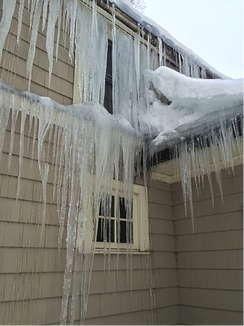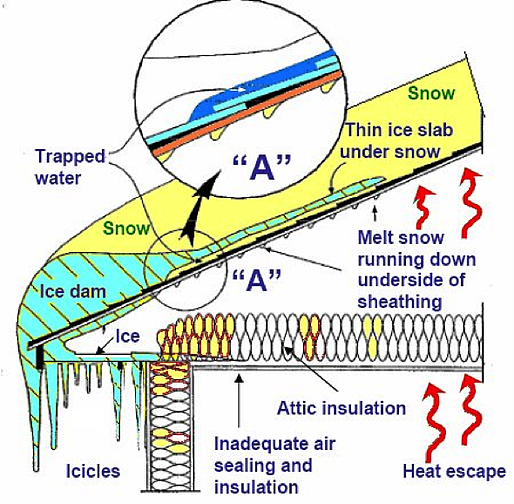Another winter of excessive snow - and ice dams - is upon us
In cold, wintery climates, ice dams are just a fact of life. While some years are worse than others (depending on the amount and timing of snowfall and temperature fluctuations), this year they are back with a vengeance - particularly in the Northeast.
In new construction, proper workmanship and a variety of techniques can make it easier to prevent ice dams and their subsequent damage. But what can property owners of existing problematic buildings do - and not do - to help prevent reoccurring leaks, stains, damaged property, and the risk of mold and mildew growth?
 What are ice dams? And how do they form?
What are ice dams? And how do they form?
- Ice dams are a wall or mound of ice that is formed at the roof edge, eave, soffit and gutters and prevents the water from melted snow from draining off the roof and where it refreezes.
- Ice dams generally form after periods of excessive snow followed by days or weeks of bitter cold and can be compounded by short periods of sleet and/or rain.
- As deep snow accumulates on roofs, it acts as an insulation layer and the snow at the roof level is melted by heat escaping from the roof/attic. The water flows down to the lower edges of the colder roof at the soffit and gutters and refreezes.
- Slowly ice builds up higher creating a mounding ice dam that prevents melted snow from draining off the roof. Ice formations and icicles can be symptomatic of ice damming.
- The water from melting snow and rain gets trapped by the high dam and forms a rising pool of water that backs up under the shingles behind the dam or over flashings when the pool of water is higher than adjacent sidewall flashings. When these conditions occur water can leak into buildings.
- Likely damages include easily observable short-term stains and soaked materials. Less observable, but equally problematic issues include wet, sagging wall and roof insulation, deteriorated wall and roof sheathing, and warping or sagging of building components.
I have ice dams. Now what do I do?
Although gutters do not cause ice dams, it is prudent to begin by keeping gutters clear of leaves and debris before the winter arrives.
First, begin with the short-term solutions. Of course, proceed with extreme caution as all roof work is inherently dangerous and often more needless damage to roofs and buildings is caused during ice dam battles. This work is best left to trained, and insured contractors as there is a fine line between diminishing ice dams and going too far with gouging roof shingles and banging fascias and gutters when removing chunks of ice that often bring roofing components down with them.
The best course is to have accumulated snow removed from roofs, as the less snow on the roof; the less water can be produced during melts. Large chucks of ice can also be removed, with applications of non-corrosive chemicals (salts) or carefully with heat and tools, but mostly just to allow water to flow out in certain areas.
Long term solutions for avoiding ice dams
While this will not help you when you're in the midst of dealing with ice dam removal and damage, there are a few key steps you can take to reduce ice dam severity and frequency.
- Keep your Roof Cold: The key is, if your roof is cold enough (close to the outside temperatures) the snow will not melt as readily to provide a source of melted water to refreeze. The key to reducing the severity and frequency of the cyclical melting and refreezing is reducing the amount of warm air at the underside of the roof.
- Reduce Heat Transfer: More insulation, properly placed, with proper ventilation are the two important keys, in that order. There are typically two situations: 1) when the space below the roof is a heated space such as with a cathedral ceiling, a sloped ceiling at a dormer or a flat roof, and 2) where the attic space is meant to be cold, with insulation in the floor of the attic.
- If you have a Cathedral Ceiling: Insulation is in the rafter space, which is usually limited, and there should be baffles installed to create a 2" channel space above the insulation and below the roof sheathing to allow cold air to flow from the eave soffit vents to a ridge vent. If these conditions do not exist or are poorly installed, heat can be readily transferred to the roof surface encouraging ice melt and ice dams. Inspections of these conditions should be left up to an expert with specialized infrared or bore scope equipment, and/or judicious examination ports to assess the situation and recommend appropriate remediation. Such an expert would be an engineer or architect familiar with building exterior envelopes and ice dam formations. These situations can be more costly to remedy and may include removal of interior or exterior finishes to add baffle vent channels, additional insulation, or to open blocked channels. In some instances, the fix is as simple as replacing ceiling lights with fixtures that reduce heat transfer or the installation of power vents on the roof to increase ventilation flow and efficiency.
- If you have an Unheated Attic: The insulation in the floor of an attic is meant to retain the heat in the space below and the attic remains unheated. Ventilation of the attic space over the last few decades has been achieved by providing soffit-to-ridge ventilation system, with soffit and ridge vents continuously along the length of the house and maintaining the attic as close to outside ambient temperatures as possible. This keeps the roof cold in the winter. Older homes use gable end louvers, fans, or just the looseness of the house framing to provide ventilation, which is generally inadequate. Steps can be taken to lessen the heat loss into the attic, and to increase the ventilation of the attic to expel heated air, both which contribute to ice dams, including:
- Install additional insulation and seal areas with insulation
- Seal wire and plumbing penetrations
- Seal areas with caulk, spray-in-place foam insulation, (in a can)
- Replace light fixtures with rated fixture that emit less heat or enclose with non-combustible gypsum baffles
- Insulate and weather-strip attic hatches
- Seal the code required airspace at the chimney and attic floor with non-combustible insulation
- Add insulation to heat producing equipment in attics, such as ducts and vents
- Be sure that bathroom and kitchen exhausts adequately vent to the exterior
- Install baffles to insulation at eaves to allow for air flow from blocked soffit vents
Protecting your home from water intrusion
Even if you take all of the above steps, ice dams are often inevitable. In addition to increasing insulation and ventilation, another key component to protecting your home is ensuring that when they do occur, there is no water intrusion.
- Use an ice and water shield: When re-roofing, a protective impervious underlayment membrane, often referred to as "ice and water shield" can be installed at the roof's edge, in valleys, up intersecting sidewalls, at chimneys and other critical areas. Install according to current building codes at a minimum, but CCA recommends at least three feet higher than code prescribed, that stepper pitched roofs require installation higher on side walls, and that a licensed engineer or architect be consulted. Generally, do not seal the whole roof with an impervious underlayment as condensation can be increased and other problems created.
- Install a cold roof: When re-roofing often the best, if not the least expensive solution, is installing a "cold roof". This can be accomplished by installing modern foam insulation into the rafters or cavity of the roof and/or installing rigid insulation on the exterior of the roof under the new roofing material. Other solutions include metal roofing or a metal roof edge. These options all have other considerations, which must be examined in more detail.
- Protect your home from fire dangers: Avoid heat tapes and electrically heated cables as they are a short-term solution at best, with real risks of fire and other leaks being created. Electrically heated shingles are another option in very isolated areas; however these are expensive and often not viable. Prevention through increased ventilation, insulation and waterproofing is the better solution.
Most importantly, be safe.
Please do not attempt to remove ice and snow from your roof by yourself, as these are dangerous conditions. If damages occur from leaks, you may wish to consider contacting your insurance company with questions and/or get approval for a disaster recover company or qualified contractor to assist with moisture removal and repairs.
For ice dam investigations and appropriate recommendations contact an experienced exterior envelope engineer or architect or please contact CCA, LLC, Engineers and Architects at (781) 280-0660 or info@ccaco.com.




